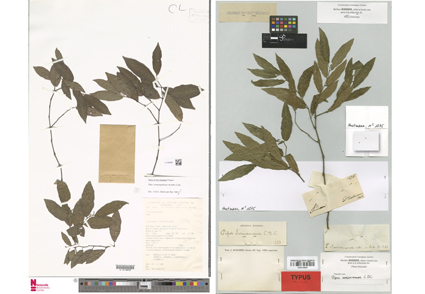Abstract
During studies of Piperaceae in Northeastern Brazil, we found names lacking designated type material, among them Piper consanguineum. We revised the synonyms, protologues and bibliographies where names have been cited. A neotype has been designated for Piper consanguineum (Kunth) Steud., as well as a lectotype for Piper surinamense C. DC., which also had a syntype excluded from its name.
References
- Candolle, A.C.P. de. (1869) Piperaceae. Prodromus systematicus naturalis regni vegetabilis 16: 235 (65)–471.
- Göppert, J.H.R. (1836) Nova Acta Physico-medica Academiae Caesareae Leopoldino-Carolinae Naturae Curiosorum Exhibentia Ephemerides sive Observationes Historias et Experimenta. Supplement. Vol. 9. 486 pp.
- Görts-van Rijn, A.R.A. (2007) Piperaceae. In: Jansen-Jacobs, M.J. (ed.) Flora of the Guianas, fascicle 24. Royal Botanical Gardens, Kew, pp. 15–163.
- Herbarium of Smithsonian National Museum of Natural History (2023) Smithsonian National Museum of Natural History: Search the Department of Botany Collections. Available from: https://collections.nmnh.si.edu/search/botany/ (accessed: 5 June 2023).
- Herbier de Guyane. (2023) L’Herbier IRD de Guyane. Available from: http://publish.plantnet- project.org/project/caypub/collection/cay/specimens (accessed: 5 June 2023).
- IPNI—International Plant Names Index. (2023) International Plant Names Index (IPNI). Available from: http://www.ipni.org/ (accessed: 5 June 2023).
- Kunth, C.S. (1815) Piperaceae. In: Humboldt, F.W.H.A., Bonpland, A.J.A. & Kunth, C.S. (1815) Nova genera et species plantarum, vol. 1. Librairie Graeco-Latino-Germani, Paris, pp. 39–61.
- Kunth, C.S. (1822) Synopsis plantarum, quas in itinere ad plagam aequinoctialem orbis novi. Vol. 1. F.G. Levrault, Paris, 491 pp.
- Kunth, C.S. (1825) Voyage de Humboldt et Bonpland, sixième partie. In: Humboldt, F.W.H.A., Bonpland, A.J.A. & Kunth, C.S. (Eds.) Nova genera et species plantarum, vol. 7. Librairie Graeco-Latino-Germani, Paris, pp. 1–479.
- Kunth, C.S. (1839) Bemerkungen über die familie der Piperaceen. Linnaea 13: 561– 726. https://doi.org/10.5962/bhl.title.110118
- Linnaeus, C. (1753) Species Plantarum, vol. 1. Impesos Laurentii Salvii, Stockolm, 560 pp.
- Melo, A. & Alves, M. (2021) Piper (Piperaceae) in eastern Northeast Brazil. Phytotaxa 505: 1–38. https://doi.org/10.11646/phytotaxa.505.1.1
- Merrill, E.D. (1943) The destruction of the Berlin herbarium. Science 98: 190–191.
- Miquel, F.A.W. (1843) Systema Piperacearum, Fasc. 1. H.A. Kramers, Roterodami, 575 pp. https://doi.org/10.5962/bhl.title.151
- MNHN—Muséum National d’Histoire Naturelle. (2013) L’herbier du Muséum: l’aventure d’une collection. Muséum National d’Histoire Naturelle, Art-Lys, Paris, 158 pp.
- Naturalis Bioportal (2023) Naturalis Bioportal: Browse Dutch natural history collections. Available from: https://bioportal.naturalis.nl/en/multimedia/U.1484099_0534609965 (accessed: 5 June 2023).
- Presl, C.B. (1851) Epimeliae botanicae. Abhandlungen der Königlichen Böhmischen Gesellschaft der Wissenschaften ser. 5, 6: 361–624.
- Pulle, A. (1906) An enumeration of the vascular plants known from Surinam, together with their distribution and synonymy. E.J. Brill LTD, Leiden, 555 pp. https://doi.org/10.5962/bhl.title.57150
- Stafleu, F.A. & Cowan, R.S. (1979) Taxonomic Literature: A selective guide to botanical publications and collections with dates, commentaries and types [TL-2]. Vol. 2, Ed. 2. Bohn, Scheltema, Junk, Ultrech. https://doi.org/10.5962/t.206091
- Steudel, E.G. (1841) Nomenclator botanicus seu synonymia plantarum universalis. Vol. 2, Ed. 2. Stuttgardiae et Tubingae. 810 pp.
- Trelease, W. & Yuncker, T.G. (1950) The Piperaceae of Northern South America: Piper. Vol. 1. Urbana University of Illinois Press, Urbana, 434 pp, 393 plates.
- Turland, N.J., Wiersema, J.H., Barrie, F.R., Greuter, W., Hawksworth, D.L., Herendeen, P.S., Knapp, S., Kusber, W.-H., Li, D.-Z., Marhold, K., May, T.W., McNeill, J., Monro, A.M., Prado, J., Price, M.J. & Smith, G.F. (eds.) (2018) International Code of Nomenclature for algae, fungi, and plants (Shenzhen Code): Adopted by the Nineteenth International Botanical Congress Shenzhen, China, July 2017. Regnum Vegetabile 159. Glashütten: Koeltz Botanical Books. https://doi.org/10.12705/Code.2018
- Yuncker, T.G. (1966) New species of Piperaceae from Brazil. Boletim do Instituto de Botânica 3: 1–370.
- Yuncker, T.G. (1972) The Piperaceae of Brazil I: Piper—group I, II, III and IV. Hoehnea 2: 23–191.


